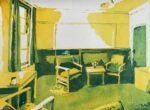Back to Christ's College tidy for another indoor landscape. This is a room in Third…

Third Stone From The Sun
It was too hot yesterday to be outside painting. So I spent the day indoors watching YouTube videos of people swatching the colours from the super granulating Schmincke collections. There are six sets of five colours: galaxy, glacier, tundra, forest, under sea and shire, although the tubes can all be bought separately. My favourite is the tundra set, and the tundra pink and tundra violet colours in particular. But looking at these colours a bit deeper, they all seem to be convenience mixes. Tundra pink, for example, is just a mixture of French ultramarine and Potter’s pink. Tundra violet is French ultramarine with Mars brown. So I ended up spending a lot of the day wondering whether I should put the tundra set on my wishlist. Or just the tundra pink and tundra violet. Or Potter’s pink and Mars brown. If I went for the set, I’d probably keep them in a separate palette but if I went for two colours, could I add them to my 18-colour palette, and, if so, what colours would be dropped?
First up is hematite violet genuine. I’ve definitely been laying this on too thickly in the past. With a bit more water, this really is pink paint with black spots and great for trees and rocks. But how does it mix with other colours?
Hematite violet with viridian. I picked viridian because it’s already a granulator on its own. Lots of background forestry texture and the garishness of the green has been toned down a bit.
Hematite violet genuine and cerulean blue make a gently granulating blue grey with the odd glimpse of red. Another interesting one.
Hematite violet genuine and quinacridone magenta. I’m not keen on this one. It just looks like a dirty application of the quinacridone magenta and I can’t imagine ever wanting to use this mix for anything. First so far that I’ve been unhappy with.
Hematite violet genuine and rose dore. Rose dore is made up of a yellow and a violet pigment and I was hoping they might show up separately. They don’t. But I still quite like this. Rose dore is an earthier colour than the quinacridone magenta, so the extra texture from the hematite feels like it belongs there.
I’m onto the yellows now. This is hematite violet genuine with Indian yellow. The red in the hematite and orange and yellow in the Indian have given this one an orangey sheen. There are lots of yellows, oranges, browns and blacks competing for attention in there, making for an interesting wash that I really didn’t see coming. This one might suit animals more than rocks.
Mixing hematite violet genuine with transparent yellow produces a mixture that has a lot in common with the last one, with oranges, yellows, browns and blacks competing for attention. But here the orange has been toned down a bit to a more yellowy level. And I’m wondering what those people who spend thousands on slices of toast that come out looking like Jesus would pay for this one.
That’s enough of the hematite violet genuine for now. Let’s move on to green apatite genuine. Here it is on its own, with little bits of red and black showing through. I need to use a more watered down version of this colour than I have been using to allow it to granulate like this.
Green apatite genuine mixed with Prussian blue is a big disappointment. No granulation anywhere in sight.
Green apatite genuine and transparent yellow. At last a colour that doesn’t eliminate all the granulation from the green. This would actually be a decent second green in a painting where the transparent yellow was my main yellow and where I was putting in green apatite genuine for trees. A nice granulating yellowish green along the top of the trees that was consistent with all the other colours in the painting would work a treat.
With green apatite genuine and Indian yellow, it’s a similar story except that the green is more olivey and less sunny as a result of using a warm yellow. So if doing a painting where I’m having trees in green apatite genuine with a bit of yellow, I should base my choice of yellow at the planning stage on whether I want the greenery to look olivey or sunshiney.
This is the Mayan blue genuine with hematite violet genuine. The hematite is amazing with just about everything, so it’s no surprise to see pinks, blues and greens popping out in this swatch.
Mayan blue genuine and viridian granulates a bit but I can’t help feeling disappointed. No extra colours are popping out in the cracks, maybe because these two colours have too much in common.
Mayan blue genuine and quinacridone magenta produce a purple with some granulation and colour variation. To be honest, that’s just a bonus. I was already pleasantly surprised that what I thought was a cool blue actually produced a violet rather than a dull grey. This is an interesting one.
When mixed with transparent yellow, Mayan blue genuine produces a really nice granulating green with the odd bit of blue showing through. An alternative to green apatite genuine but not a direct replacement as the green apatite has black and reds showing.
And finally here’s Mayan blue genuine and raw sienna. An earthier mix than the last one, with more brown showing through and less blue. This feels closer to green apatite genuine, not that it really matters.
































Leave a Reply